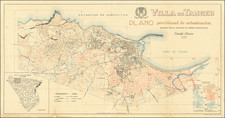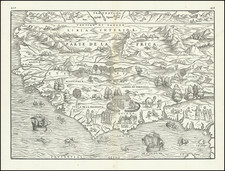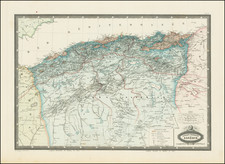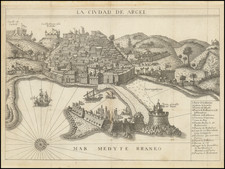The First Printed Map/View Engraved by Hieronymus Cock -- The Capture of Mahdia in 1550
The second known example this broadside of the Capture of Mahdia, the first map or view engraved by master engraver Hieronymus Cock and the only example to include a printed title.
Cock’s view shows a circular building representing the city’s main mosque. Invading troops at right have begun to damage the defensive walls, but Ottoman crescent flags still fly from the towers. The European forces are identified by flags with Habsburg double-headed eagles, as shown on two ships in the left foreground and an a standard carried by ground troops at the right.
At the right margin, cavalry bearing a crescent flag charge an infantry group that carries flags emblazoned with Christian crosses. This vignette may refer to a sortie that Ottoman forces made in the vicinity of the olive groves during the siege of Mahdia. Cock clearly distinguishes Habsburgs from Ottomans whereas Forlani’s later 1562 view shows unidentified cavalry arrayed in the foreground who approach Mahdia from all sides, whether friend or foe.
Between 1550 and 1570, Cock engraved 27 maps and topographic views. This view is the earliest surviving example of a map or topographical view engraved by Cock in the style of a map or view, depicting a current event and one of two published by Cock in 1550, the other being a large 2-sheet view of Lyon engraved for Cock by Balthasar Bos.
In describing this image, Serebrennikov notes:
No privilege, nor even identification, accompanies an etching which is signed 'Hieronymus Koek Ffecit] et Excudebat 1550' . . . From land and sea, imperial troops and their allies besiege a fortified town flying the Turkish crescent. The inscription sechagne at the entrance to the interior port indicates the presence of shoals and not, as has been suggested, the name of the settlement. Rather, this is the Siege of Mahdia, or Afrika as it was known to Europeans. . . .
By mid-December of 1550 the French ambassador to the court at Constantinople had written back that imperial accounts of the fall of Mahdia had been available in print there for two months. Indeed, the earliest published account that has survived is an eye-witness report of the situation as of the thirteenth of September, which appeared that same month in Nuremberg. A similar account was probably was intended to accompany Cock's etching, given the blank area reserved at the upper margin and the numeral '17' just above the interior port. Certainly it was an eyewitness who provided the model that Cock used for his view of the besieged town. . . .
Capture of Mahdia
The Capture of Mahdia was an amphibious military operation that took place from June to September, 1550, during the struggle between the Ottoman Empire and the Spanish Habsburgs for the control of the Mediterranean.
A Spanish naval expedition under the command of the Genoese condottiero and admiral Andrea Doria and the Spaniard Bernardino de Mendoza, supported by the Knights of Malta under their Grand Master Claude de la Sengle, besieged and captured the Ottoman stronghold of Mahdia or Mahdiye. Mahdia was defended by the Ottoman Admiral Turgut Reis, known as Dragut, who was using the place as a base for his piratical activities throughout the Spanish and Italian coasts.
Sancho de Leyva remained in Mahdia in command of a Spanish garrison until 1553. Charles V offered the charge of the town to the Knights of Malta but they refused it, so he ordered it to be dismantled despite it being a strategically important stronghold. Shortly after Mahdia was reoccupied by the Ottomans. The town remained under Turkish rule until the 19th century. Sultan Suleiman, meanwhile, considered that Charles had broken the Truce of Adrianople and ordered Turgut Reis to resume the war against the Christians. After summoning up Turkish reinforcements he returned to the Barbary coast in August 1551, and succeeded in capturing Tripoli from the Knights of Malta. In 1560, he helped to defeat a Christian fleet at the battle of Djerba, but failed in an effort to take Malta, a failure that, together with that of the Ottoman governor of Algiers before Oran ans Mers El Kébir, allowed the capture in 1564 by Spain of Peñón de Vélez de la Gomera, a Christian success which was followed in 1565 by the decisive defense of Malta against the fleet of Turgut Reis.
Rarity
The present example includes a title at the top in Latin, which is printed on a separate piece of paper.
We locate only a single surviving example (no title) at the Rijksmuseum.
Hieronymus Cock (1518-1570) was a skilled Flemish engraver, painter, and publisher of prints in the sixteenth century. He hailed from an artistic family, as his father and brother were both painters as well. He trained as a painter in Antwerp and then spent time in Rome (1546-7).
Cock and his wife, Volcxken Diercx, established their publishing house in 1548 at Aux quatre vents, or at the house of the four winds. Cock’s publishing house became renowned in northern Europe as he and his wife, and successor, transformed printmaking from an individual activity to one based on a division of labor. This allowed him to publish more than 1,100 prints in just over two decades (1548-1570). He is known to have personally etched 62 plates.
Cock’s cartographic output included country maps, landscape prints, and town plans, especially of cities under siege. He also worked with mapmakers; for example, he collaborated with Diego Gutiérrez on a 1562 map of the America. He famously released prints by important engravers who produced works after the Italian masters of the Renaissance, popularizing that movement in the north of Europe.












![Fessae, et Marocchi Regna Africae Celeberr. describebat Abrah. Ortelius. 1595 [with large inset of West Africa]](https://storage.googleapis.com/raremaps/img/small/95634.jpg)
![[ The Honorable Kingdom of Morocco ] المملكة المغربية الشريف](https://storage.googleapis.com/raremaps/img/small/96404.jpg)
